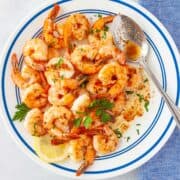2-Ingredient Pan Seared Shrimp Recipe
Pan seared shrimp has fantastic flavor and texture, thanks to a cooking method that browns the exterior of the shrimp without overcooking it.
This shrimp is great hot or cold and can be a main course with rice or buttered noodles and a veggie on the side. Or, you can add these shrimp to tacos, salads, pasta dishes and more.
- Prep Time: 5 minutes
- Cook Time: 3 minutes
- Total Time: 8 minutes
- Yield: 1 pound of shrimp 1x
- Category: Salmon and Seafood
- Method: Pan Sear
- Cuisine: American
Ingredients
- 1 pound defrosted, peeled and deveined shrimp, tails on or off
- 2 tablespoons butter or oil, or a combination of both
Instructions
- Pat the shrimp dry with a paper towel.
- If you’d like to add any spices, sprinkle the spices over the shrimp and toss well (see the blog post above for seasoning suggestion).
- Heat a wide (12-inch) non-stick skillet over medium-high heat.
- When the pan is hot, add 1 tablespoon of the butter or oil.
- Wait about 30 seconds to heat the butter or oil, then add HALF of the shrimp.Spread the shrimp out in one even layer.
- Let the shrimp cook for a little less than 2 minutes. Don’t stir or move the shrimp.
- Just before the 2 minute mark, flip all of the shrimp over.
- Lift the skillet up off the direct heat of the stove and let the shrimp cook for 1 minute or slightly less without direct heat under the skillet.
- Immediately transfer the shrimp to a serving platter when they are done. The shrimp are done when they're opaque (not translucent) and no longer have a grayish color. It will have an appetizing orange/pink color. The shape of cooked shrimp will be curved, but it shouldn't be a super firm and tight "C". It's best to error on the side of taking shrimp out of the skillet a few seconds too soon, rather than a few seconds too late!
- Set the skillet back over the heat and add the remaining tablespoon of butter or oil.
- Add the remaining shrimp.
- Follow the steps above: sear the shrimp for just under 2 minutes then flip them over. Turn off the heat and cook for about 1 minute more.
- If you'd like, finish the shrimp with a squeeze of lemon or lime.
Notes
The type of fat used to sear the shrimp will affect the flavor. Any type of fat is fine, just choose what sounds good to you. Do you want buttery shrimp? Or a lighter coating of extra virgin olive oil? Vegetable oil won’t add any detectable flavor. Coconut oil, on the other hand, will.
Adding Garlic, Herbs and Spices
See the section "Seasoning Suggestions" in the blog post above for suggestions of herbs and spices to add.
Use ½ to 1 teaspoon of a spice or seasoning per pound of shrimp. Pat the shrimp dry and then season before adding to the hot skillet.
Garlic or ginger can be added to the skillet after the shrimp have already cooked for 2 minutes and are flipped over. If you added it sooner than that, the garlic might burn.
If adding lemon or lime juice, wait until the shrimp are completely cooked then toss with a squeeze of citrus.
Fresh herbs can be added before or after the shrimp are cooked.
Before seasoning with salt, check the ingredient list on the bag of shrimp. Many brands of frozen shrimp have salt added.
Storage and Leftovers: Cooked shrimp should be kept in the refrigerator and eaten within 2 to 3 days. If the shrimp has gone bad it will have a strong fishy odor.
Find it online: https://www.kitchenskip.com/pan-seared-shrimp/
